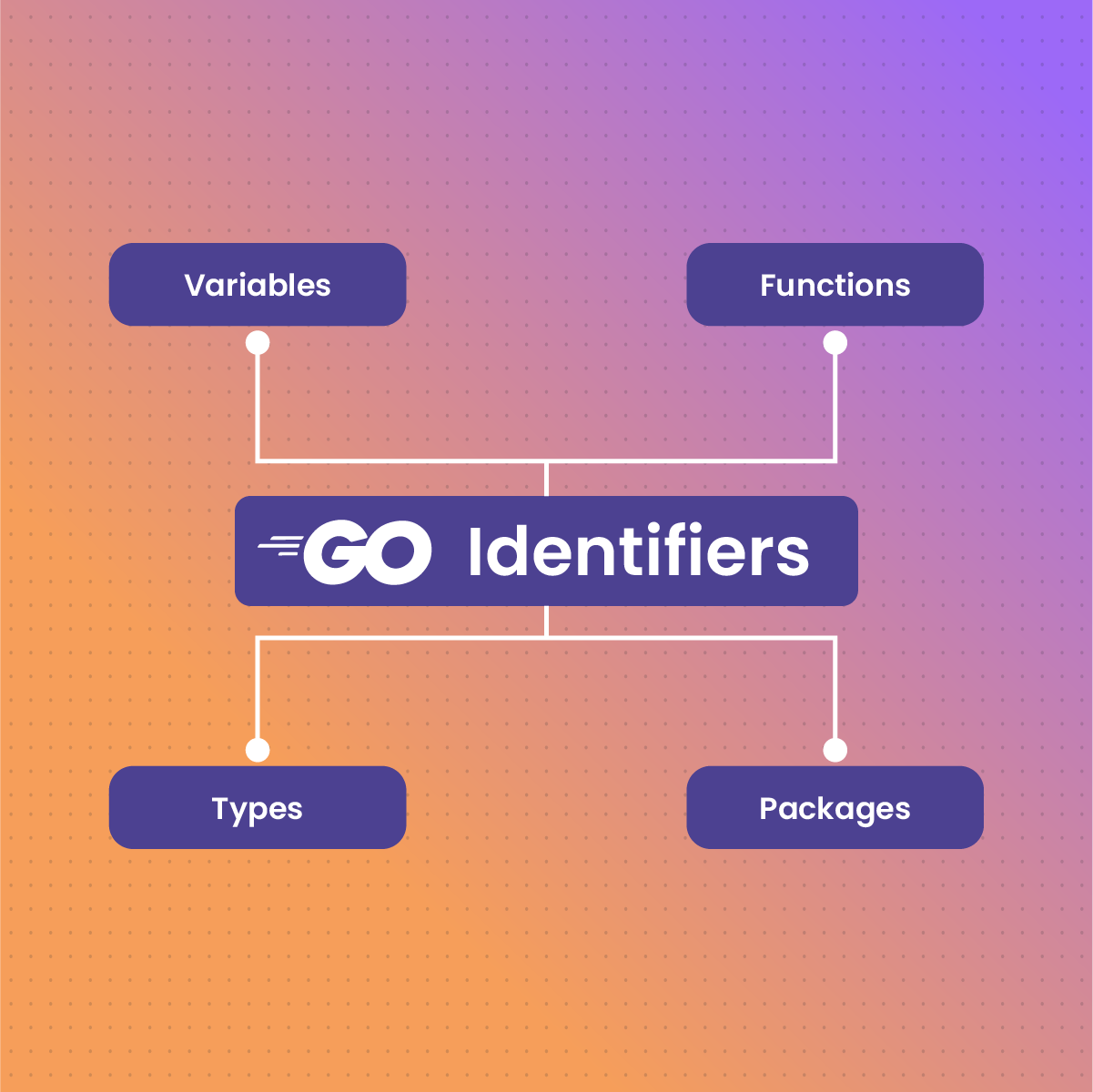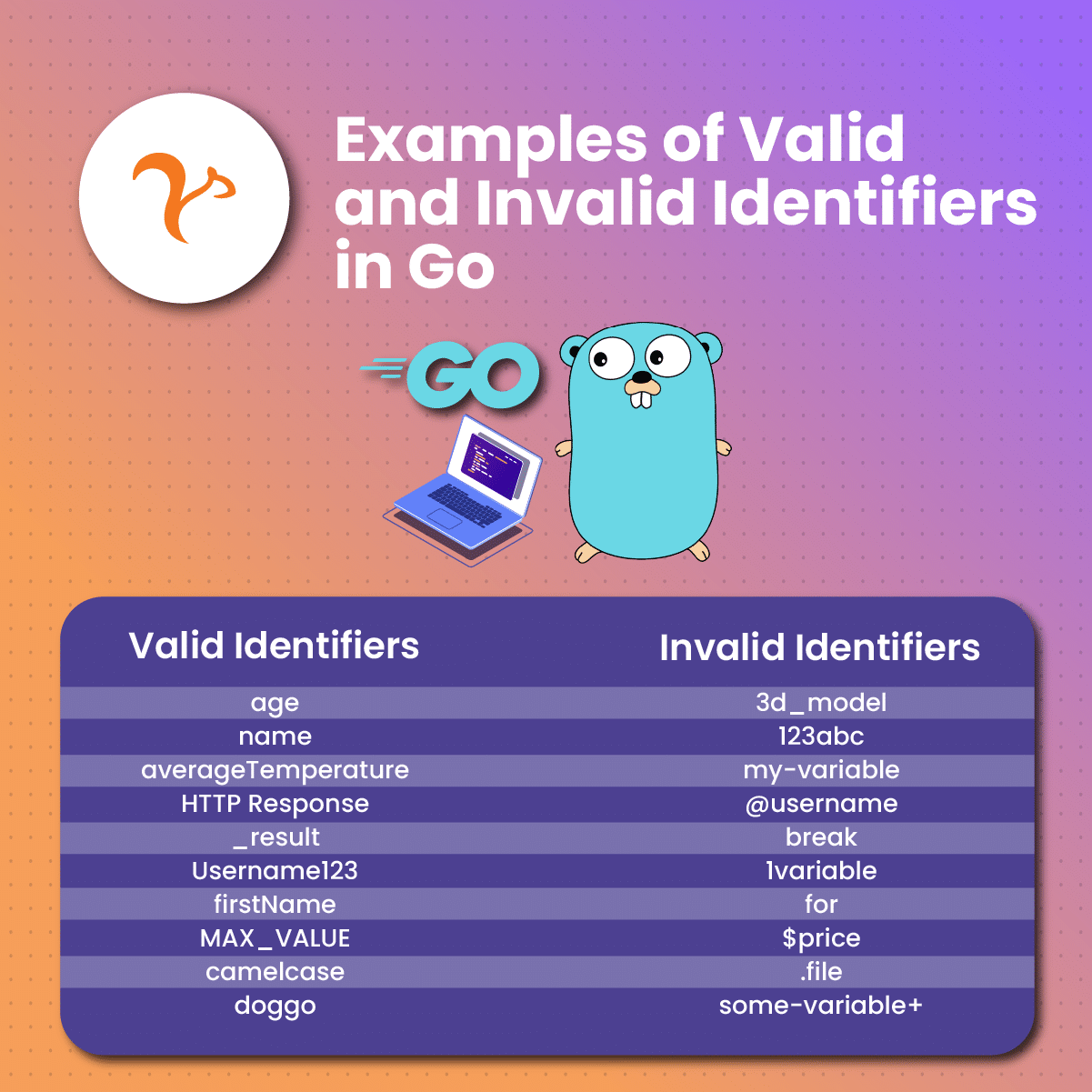In the massive context of programming languages, Go, which could also be referred to as Golang, has emerged as an efficient and powerful programming language. One of the distinctive features of Go is the use of identifiers, which play a vital role in coding practices. In this comprehensive guide to Go Identifier, we will holistically explore the world of Go Identifier, delving into its best practices, significance, and how Go Identifier can contribute immensely to writing maintainable and clean code.
Brief History of Go Identifier
Go Identifier has been used as a name to represent functions, types, variables, and other user-defined constructs. It is unique within its scope and follows certain naming conventions. The first Go Identifier was introduced in the initial language in 2009. It was predicated upon the Identifier used in C that had some additional restrictions. For instance, the Go Identifier cannot start with an underscore, and it cannot contain whitespace. The Go Identifier was upgraded in 2012 to support Unicode identifiers. The preceding implies that Go Identifier can now embrace characters from any language, including Korean, Japanese, and Chinese.
The Go Identifier was updated in 2015 to support user-defined identifiers. The preceding means that programmers now have the platform to define their keywords for use in their code. However, there must be no conflict between user-defined identifiers and any of the reserved keywords in the Go Identifier language. Go Identifier is an essential aspect of the Go language, which has evolved over the years to satisfy the needs of Go programmers. Currently, the set of Go Identifiers is intended to be both easy to use and expressive. This development is likely to continue to evolve in the future.
What is a Go Identifier?
In the context of Go programming, a Go Identifier is a name given to a function, variable, type, constant, or any other user-defined item. Go Identifier is used to refer to the item in the code. Go Identifier is case-sensitive, which means that uppercase letters are considered different from lowercase letters. A good example to illustrate this difference is given below:
“MyVariable” and “myVariable” are two different Go Identifiers.
Identifiers are fundamental components of the language, allowing developers to reference and manipulate data and functions effectively within their code. They play a crucial role in the readability and maintainability of Go programs.
A Go identifier must begin with a letter (a-z or A-Z) or an underscore (_) and can be followed by any combination of letters, digits (0-9), and underscores. For example, valid identifiers include variableName, function_name, CONSTANT1, and _temp. It’s important to note that Go is case-sensitive, meaning that VariableName and variablename would be considered different identifiers.
The naming conventions for Go identifiers emphasize clarity and consistency. For instance, variable and function names typically use camelCase, starting with a lowercase letter for local variables and functions, while exported names (those that need to be accessible outside the package) start with an uppercase letter. Constants and package-level variables often use ALL_CAPS with underscores to separate words, although this is less common in Go compared to other languages. By following these conventions, Go developers ensure that their code is not only syntactically correct but also easy to read and understand for other developers.
Importance Of A Go Identifier In Code Readability
In the vast realm of the Go programming language, the Go Identifier plays an important role in code readability and maintainability. The importance of Go Identifier in code readability can be expressed and explained through several key points:
It Promotes Descriptive Naming
A descriptive and meaningful Go Identifier contributes significantly to the overall clarity of the code. When your code is read by people, they should be able to understand the role and purpose of different variables, types, functions, and other entities. When you use a well-chosen Go Identifier, it makes it easier for others, including yourself, in the future to understand the logic and functionality of the code.
It Serves As Self-Documenting Code
Perspicuous Go Identifier functions as a form of self-documentation; instead of depending solely on comments to explain the purpose of functions or variables, a curated Go Identifier can convey much of that information. Functioning this way minimizes the need for extensive comments and aids developers in quickly comprehending the intent of the programming code.
It Facilitates Consistency
One of the factors that boosts overall readability is consistent naming conventions across the codebase. When the Go Identifier follows a consistent pattern, it aids the developers’ ability to predict and understand the names of different elements easily. The Go Identifier’s community often complies with conventions such as PascalCase for type names and camelCase for variable names.
It Helps Avoid Ambiguity
A well-chosen Go Identifier helps avoid ambiguity in the code, which enhances the readability of the code. Unclear or ambiguous names can make it easier to grasp the purpose of different elements. Clear Go Identifier contributes significantly to a less error-prone and straightforward codebase.
It Supports Refactoring And Maintenance
As programming code evolves, developers typically need to modify or refactor existing code. Clear and consistent Go Identifier promotes easy understanding of how to refactor without the introduction of errors. When a function or variable needs to be upgraded, having a meaningful Go Identifier helps developers quickly comprehend the context and make the necessary changes.
Components Of A Go Identifier
Highlighted below are the components of a Go identifier:
Letters
Go Identifier contains letters from the Unicode character set. This incorporates letters from the Latin alphabet (a-z, A-Z) and letters from other alphabets, such as Arabic, Cyrillic, and Greek.
Digits
Go Identifier also contains digits ranging from 0 to 9. These digits can be used anywhere in a Go Identifier, which includes the beginning.
Underscores
In Go Identifier, the underscore (_) character is used to enhance readability. The underscores character can be used at the beginning, middle, or end of a Go Identifier.
Case sensitivity
A Go identifier is case-sensitive. The preceding implies that the names WilsonName and wilsonName are considered to be different Go identifiers.
Keywords
Keywords are often used In the Go language, and these keywords are reserved and have special meanings. Keywords cannot be used as a Go Identifier. For instance, the keyword var cannot be used as a variable name.
Length
In terms of length, a Go Identifier does not have a limit. However, it is advised to use a Go Identifier that is meaningful and easy to read.
Unicode characters
A Go Identifier can contain Unicode characters, which allows for the use of non-ASCII characters in names.
Examples Of Valid And Invalid Go Identifiers
Listed below are some examples of valid Go Identifiers:
- firstName
- myAge
- _temp
- customerID
- packageMain
Listed below are some examples of invalid Go Identifiers:
- 123abc (starting with a digit)
- for (keyword)
- -myVariable (starting with a hyphen)
- my variable (containing spaces)
- myVariable@ (containing invalid character)
Scope, Visibility, And Shadowing Of A Go Identifier
In Go Identifier, the scope, visibility, and shadowing of identifiers play an essential role in maintaining the clarity of code and preventing unexpected behavior. Understanding these concepts is crucial for writing Go programs that are well-structured and maintainable.
Scope
The scope of a Go Identifier has to do with the portion of the program where the Identifier can be used to gain access to its associated object. It is used to identify the regions of the programming code where the Go Identifier is recognizable and can be referenced. Go Identifier uses lexical scoping, which is also known as static scoping. The preceding means that the scope of a Go Identifier can be determined by its physical position in the source code, not by the flow of its runtime.
Highlighted below are the two primary types of scope in Go Identifier:
Block Scope
Variables that are declared within a code block, such as loop, conditional statement, or function, have block scope. The preceding means that they can only be accessible within the boundaries of that block and cannot be accessed from outside the block.
Package Scope
Variables that are declared outside of any function, directly within a package, have a package scope. These variables can only be accessible throughout the entire package scope in which they are identified.
Visibility
On the other hand, the visibility of a Go Identifier refers to the accessibility of an identifier within a program. It helps determine which parts of the code can access and modify the object associated with the Identifier. Go Identifier generally follows the encapsulation principle, which means that a Go Identifier with restricted visibility is protected from unintended access and modification.
The visibility of a Go Identifier depends on its scope and declaration location, as expressed below:
Package-Level Visibility
A Go Identifier declared at the package level, outside of any function, has the visibility of the package level. The preceding implies that the Go Identifier is accessible from any other file within the same package.
Function-Level Visibility
A Go Identifier declared within a function has the visibility of function level. This Go Identifier is only accessible from within that function level and cannot be accessed from outside of it.
Shadowing
In Go Identifier, shadowing is a phenomenon where an inner block declares a variable with the same name as a variable of an outer block. The inner variable within the inner block takes precedence, and the variable from the outer block becomes inaccessible. This character ensures that the variables that have the same name do not interfere with each other, accelerating cleaner code.
Best Practices For Go Identifier
When writing a Go programming code, it is crucial to use a Go Identifier that is consistent, clear, and easy to understand. This practice will make your programming code more readable and maintainable for you and other developers. Mentioned below are some of the best practices for Go Identifiers:
Use Descriptive Names
An identifier’s name should clearly indicate what it stands for. For example, rather than using a variable named x, you can use a more descriptive name, such as productPrice or customerName.
Use A Consistent Naming Scheme
Be consistent in naming your identifiers. For instance, you could use all camel cases for function names and lowercase for variable names.
Use Moderately Short Names
Identifiers’ names should be moderately short to be easy to read and write, but avoid extremely short names that are ambiguous. For instance, custName is too short and could be confusing, but customerName is a good name.
Don’t Use Underscore Characters
Underscore characters are generally considered a bad style in Go code. Instead, use a camel case.
Avoid Using Reserved Words
Words that have special meaning in Go Identifier and cannot be used as identifier names are referred to as reserved words. For example, func, if, and var are reserved words.
Use Exported Identifiers Names For Public Go Identifier
Exported Go identifier is an identifier that is visible outside of the package in which they are defined. The first character of the exported Identifier’s name should be in the Unicode uppercase letter.
Think About The Context
An identifier’s name should make sense in the context in which it is used. For instance, the name customerName makes sense within a function that deals with customers, but it will not make sense within a function that deals with products.
Use Consistent Naming Conventions For Similar Identifiers
If you are dealing with multiple identifiers that are related to each other, give the identifiers similar names. For instance, if you have a variable named customerName, you could also have variables named customerEmail and customerAddress
Be Confident To Change Names
If you realize that the name of an identifier is not clear or is causing confusion, be confident to change it. It is more palatable to have clear and consistent names than to have names that are misleading or confusing.
Avoid Using Generic Names
Do not use generic names such as value, data, or temp unless the purpose is genuinely generic.
Common Use Cases And Conventions For Go Identifier
The use of Go identifier in real-world Go code complies with best practices and certain conventions to ensure maintainability, readability, and consistency across projects. Highlighted below are some common use cases and conventions for Go identifier:
Camelcase Naming Convention
Go identifier uses camelCase for naming variables, types, functions, and most identifiers.
Pascalcase For Exported Identifiers
Go Identifier that starts with an uppercase letter is exported and can be accessed from other packages. It is recommended to use PascalCase for such identifiers.
Abbreviations
To achieve readability, ensure the use of common abbreviations. But do not use overly cryptic names.
Package Names
Package names should be lowercase, short, and indicative of the purpose of the package. Do not use unnecessary acronyms and abbreviations.
Constants
Typically, constants are written in uppercase with underscores between words.
Receiver Names in Methods
When specifying methods on types, use meaningful and short names for the receivers.
Error Variables
When dealing with errors, it is a conventional practice to use err as the variable name.
Do Not Use One Or Two Letter Identifiers
Except you are dealing with very short-lived variables, such as loop counters, ensure to use names that are more descriptive to boost code readability.
Contextual Naming
Choose names that convey the meaning or purpose of the variable, type, or function. This aids in making the code self-explanatory.
Do Not Use Underscores
Usually, Go isn’t used for separating words in identifiers. Instead, use PascalCase or camelCase.
Impact Of Poorly Chosen Go Identifier On Code Maintainability
Choosing well-thought-out and meaningful Go Identifiers, including function names, variable names, and other identifiers in Go code, is essential for the readability and maintainability of code. When Go identifier is poorly chosen, it can have several negative impacts, which are:
Readability And Understanding
Code becomes difficult to read and understand when Go Identifier is poorly chosen. Developers who read the code might struggle to comprehend the functionality and purpose of functions, variables, or other elements.
Maintainability
The code maintainability is immensely compromised when Go identifier is not descriptive and clear. It might be challenging for developers to make updates or changes to the code, maximizing the likelihood of introducing errors during modifications.
Collaboration
In a development environment where collaboration is upheld, other team members might need to work with or maintain the code. If the Go Identifier is poorly chosen, it may culminate in misinterpretation and confusion among team members.
Debugging
During debugging, meaningful and curated Go Identifiers can serve as useful clues essential for understanding the flow of the program and locating issues. A poorly chosen Go Identifier can make it difficult to identify the root cause of the problems and track down bugs.
Documentation
Meaningful and well-thought-out Go Identifier can function as self-documenting code, reducing the need for extensive comments. A poorly chosen Go Identifier may need additional documentation to explain their purpose, adding extra burden for developers.
Refactoring Challenges
When the time to optimize or refactor code comes, having a meaningful and clear Go Identifier makes the process much smoother. Poorly chosen Go Identifier can complicate refactoring efforts, potentially leading to incorrect or incomplete changes.
Code Reviews
Maintaining code quality requires code reviews. If Go Identifier is ambiguous or unclear, it can result in misunderstandings and discussions during the code review process, capable of slowing down the overall development workflow.
Scalability
The impact of poorly chosen identifiers becomes more pronounced as a codebase grows. Maintaining clarity and consistency becomes increasingly daunting, making it difficult for developers to navigate and contribute to the codebase.
Tools And Resources For Go Identifier
Given below are some tools and resources that can be useful for working with Go identifier:
Go Documentation
The official documentation is a holistic resource that incorporates information on Go identifier, naming conventions, and other features of the language.
Go Guru
Go Guru is an online tool that offers a ton of features, including finding references to Go Identifier, finding the definition of Go Identifiers, and more. It is part of the golang.org/x/tools package.
GoLint
GoLint is a linter tool for Go Identifier that checks your code for common mistakes, including naming conventions for identifiers. GoLint can ensure that your code follows the recommended naming conventions.
GoFmt
GoFmt is an online tool that formats Go Identifier code. While this online tool may not directly deal with identifiers, it can help maintain a consistent style in your codebase, which includes how identifiers are named.
Static Analysis Tools
Staticcheck is a static analysis online tool for Go Identifier that can catch common programming errors, which includes issues that are related to identifiers. This online tool can be used to ensure code quality and adherence to best practices.
Visual Studio Code with Go Extension
If you employ Visual Studio Code, the Go extension provides features such as error checking, IntelliSense, and code navigation, which makes it easier to work with Go Identifier in your Go code.
Go Playground
The Go Playground is an online tool that allows you to write, share, and execute Go code. It is useful for quickly testing and experimenting with different identifiers and their usage.
Online Go Resources
Websites like Learn Go with Tests and Go by Example provide hands-on exercises and examples that can help you understand how to use Go Identifier in various contexts.
The Role Of Documentation In Conveying Go Identifier Usage
Documentation plays an important role in conveying Go identifier usage by providing context, clarity, and guidance to developers. Mentioned below are some ways in which documentation contributes significantly to understanding Go identifier usage:
Explanation Of Purpose
Documentation helps in describing the purpose and functionality of each Identifier, including types, functions, variables, and packages. Documentation aids developers in understanding what a particular identifier is meant to achieve.
Usage Examples
Providing code examples showcases how to use Go identifier in various contexts. This activity enables developers to understand the syntax and usage patterns, making it more straightforward to apply the Identifier in their code.
Details about Parameter and Return Value
For methods and functions, documentation usually includes information about parameters and return values. Clear explanations of each parameter, its purpose, and its type enable developers to use the Identifier correctly.
Package-level Documentation
At the package level, documentation outlines the overall purpose and usage of the package. It explains how the Go Identifier within the package works together to achieve specific goals.
Code Comments
Besides external documentation, comments that are properly placed within the code itself can provide additional context for individual identifiers. These comments explain the rationale behind certain design choices or highlight important considerations.
Frequently Asked Questions About Go Identifier Language Naming Conventions
What Are The Advantages Of Employing Go In Identifiers?
The simplicity of Go in identifiers accounts for its powerful performance. Go complies quicker, runs faster, easy to support and maintain, and allows for shorter software development lifecycles. Go in identifiers comply directly with machine code since it does not use virtual machines, offering a better speed advantage.
What Is The Main Characteristic Of Go In Identifiers?
One of the primary features of Go in the identifiers programming language is its concurrency behavior. Unlike other programming languages, Go in identifiers provides easy and trackable concurrency options.
What Is The Maximum Length Of A Go Identifier?
A Go Identifier does not have a maximum length for identifiers. It is a good practice to keep them reasonably short and meaningful.
Go Identifier: Final Thoughts
Gaining mastery of the art of Go Identifier is vital for every Golang developer. This comprehensive guide has provided a detailed understanding of identifiers, practical examples, best practices, common use cases, conventions for Go identifiers, the impact of poorly chosen Go identifier on code maintainability, etc. By complying with the principles explored in this post, developers can upgrade their coding skills and contribute significantly to a more robust Go programming ecosystem.








